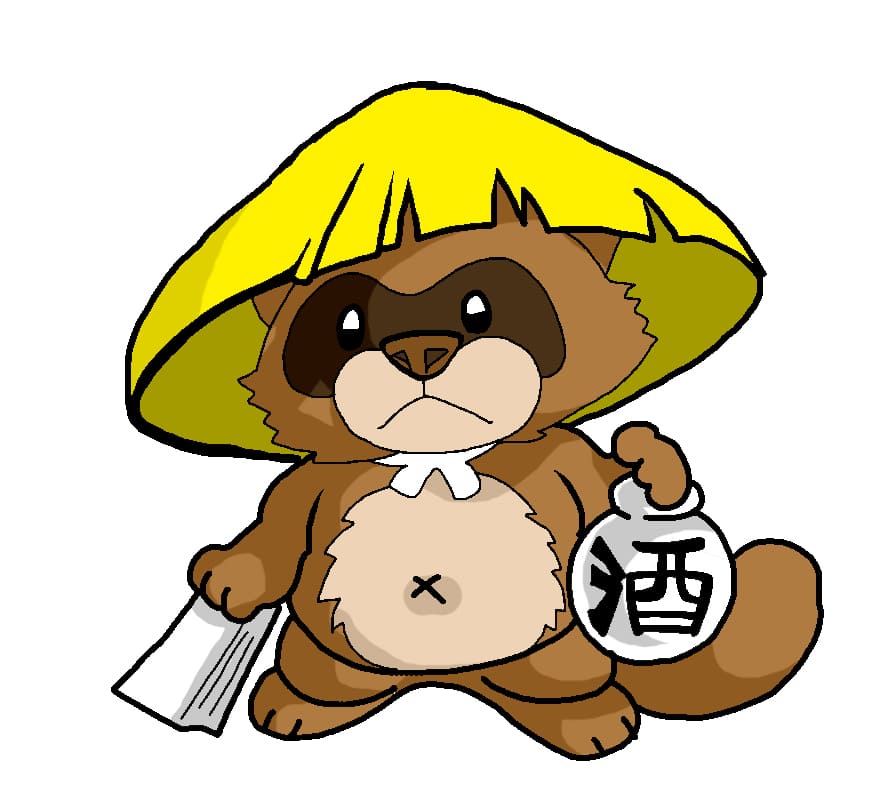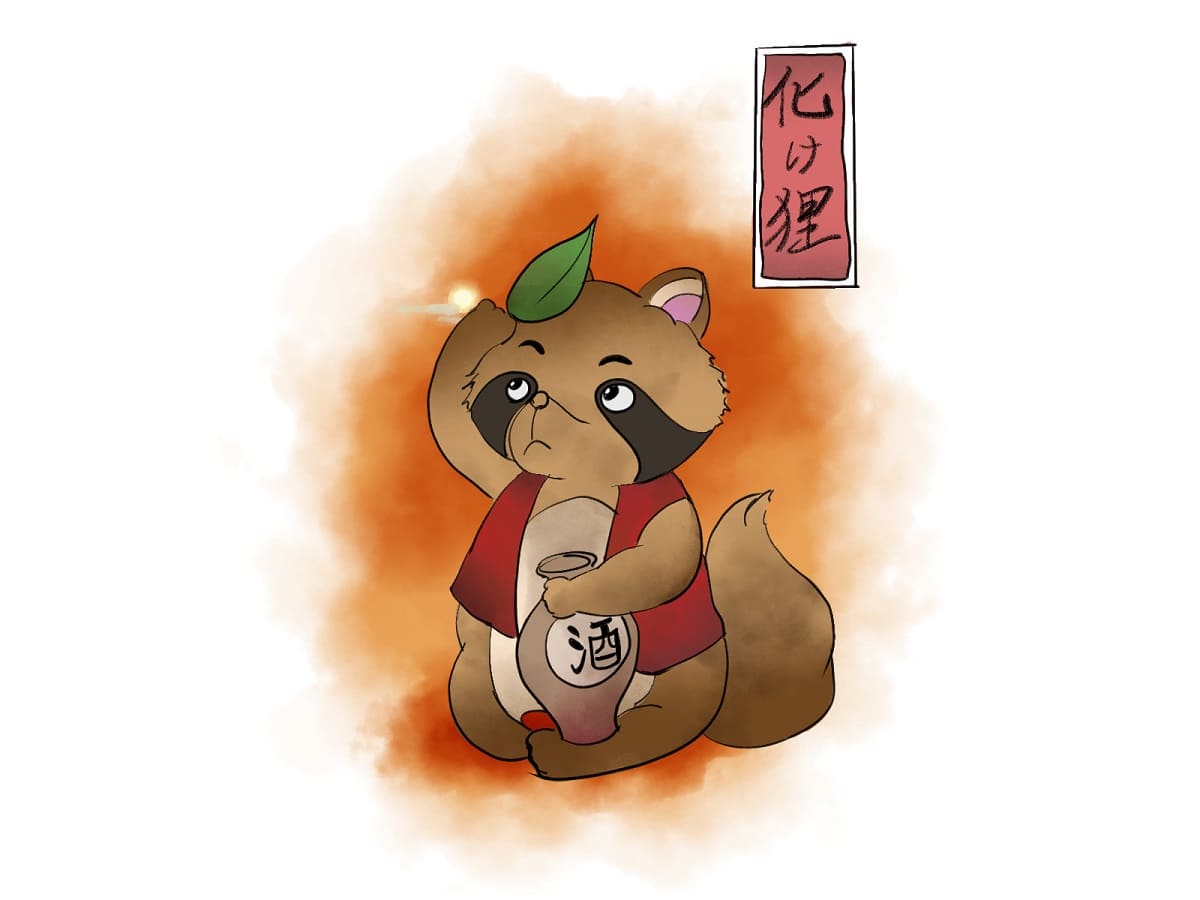In Japanese folklore, bakedanuki are shapeshifting yokai (supernatural beings) that originate from ordinary raccoon dogs—known as tanuki—who gain magical powers as they age. Much like the mythical Nekomata (monster cats) or Yoko (fox spirits), bakedanuki can deceive humans using illusions, transformations, or even possession.
Throughout Japan’s many folktales, it’s common to see bakedanuki outsmarting people, transforming into other creatures, or engaging in magical duels. But they’re not always tricksters—in many stories, they also help humans or perform good deeds. Compared to foxes, which are often portrayed as sly and cunning, tanuki are usually seen as charming and humorous, adding a bit of lightheartedness to Japanese folklore.

Tanuki move slowly and are just so cute! I love how they use leaves when performing magic—it’s adorable!
Famous Bakedanuki Legends in Japan

I’m going to talk about famous Bakedanuki in Japan.
Danzaburou-danuki (Sado Island)

Danzaburou is considered the head of all tanuki on Sado Island. Locally, tanuki were called mujina, so he’s also known as Danzaburou Mujina.
This bakedanuki was known for creating walls on dark roads to confuse travelers or turning leaves into money to shop in human towns. Interestingly, he once disguised himself as a human to visit a doctor when he was sick. Despite his mischief, Danzaburou was also known for helping people in need, often leaving them with money.

They say there are no foxes on Sado Island because Danzaburou-danuki drove them all out!
Shibaemon-danuki (Awaji Island)

Living on Mount Mikuma in Awaji Island, Shibaemon was a fan of kabuki theater in Osaka’s Dotonbori area. He would often disguise himself as a human to watch performances, especially those featuring his favorite actor, Kataoka Nizaemon I.
However, he once tried to pay with leaves and was attacked by dogs—dying as a result. After his death, he haunted the theater until the owners built a shrine for him. From that point on, the theater became wildly successful, and Shibaemon became known as a god of performance arts.
Tazaburou-danuki (Yashima, Kagawa)

During the early Heian period, Tazaburou-danuki helped the famous monk Kobo Daishi find his way after getting lost. Impressed, Kobo Daishi made him the guardian spirit of Yashima Temple.
Later, during the Heian era, Tazaburou also became an ally of the Taira clan after being saved by Taira no Shigemori.

Tazaburou-danuki was a master of transformation.
They say his shapeshifting skills were the best in all of Japan.
Anime Featuring Bakedanuki

The Eccentric Family (Uchouten Kazoku)
Set in Kyoto, this anime follows the Shimogamo family of tanuki, whose father was once the head of all tanuki but was turned into tanuki stew. The story explores family bonds, rivalry with the rival Ebisugawa clan, and relationships with tengu and humans in a colorful and whimsical setting.
Poco’s Udon World (Udon no Kuni no Kin-iro Kemari)
Set in Kagawa Prefecture, the anime tells the story of Souta Tawara, who returns to his hometown after his father’s death and meets Poco, a tanuki disguised as a human child. Through interactions with Poco, his family, and childhood friends, Souta gradually comes to terms with his past and matures emotionally.

I’ve read Poco’s Udon World (Manga).
The ending scene really brought tears to my eyes.
Pom Poko (Heisei Tanuki Gassen Ponpoko)
Directed by Studio Ghibli, Pom Poko tells the story of tanuki living in Tokyo’s Tama Hills. When their forest home is threatened by urban development, they use their magical transformation abilities to resist the humans. This animated film blends humor, action, and environmental messages, highlighting the tanuki’s adaptability and spirit.

I watched Pom Poko on the bus during a school field trip!
It’s an old anime, but it was actually pretty fun.
Q&A about Japanese Tanuki Yokai Bakedanuki

- QWhat’s the difference between tanuki and bakedanuki?
- A
Tanuki are real animals (Japanese raccoon dogs). A bakedanuki is a legendary tanuki that has lived a long time and gained supernatural powers, becoming a yokai. Think of it as an “evolved” version of a tanuki.
- QAre bakedanuki evil?
- A
Not necessarily! While some bakedanuki play tricks on people, others help humans or even become protective spirits. Their personalities vary by region and story.
- QAre there really tanuki in Japan today?
- A
Yes! Tanuki are common in rural and even some urban areas of Japan. They’re nocturnal and often shy, but you might spot one in the countryside.
- QDo all tanuki become bakedanuki when they get old?
- A
In folklore, only the clever or lucky ones become bakedanuki. They’re often said to gain magical powers after living for many years—especially over a hundred.
- QWhat’s with the leaves? Why do tanuki use them in magic?
- A
According to legend, tanuki use leaves as magical items—often placing them on their heads or turning them into gold to trick people. It’s one of their signature moves!
Final Thoughts about Japanese Tanuki Yokai “Bakedanuki”
From mischievous tricksters to loyal allies and even gods of theater, bakedanuki are deeply woven into the cultural fabric of Japan. With their unique blend of magic, charm, and humor, these tanuki yokai continue to capture the imagination—both in traditional folklore and in modern anime.
If you’re fascinated by yokai or enjoy anime with supernatural themes, bakedanuki stories are a delightful place to start. Whether as mountain guardians, kabuki lovers, or adorable companions, these mythical raccoon dogs are full of surprises!

If you are interested in Japanese yokai, and you love gaming, you may love these games! Let’s play!

Yes! Let’s play!




Comments